Best sports bras for cycling: the search for support and quick-drying properties
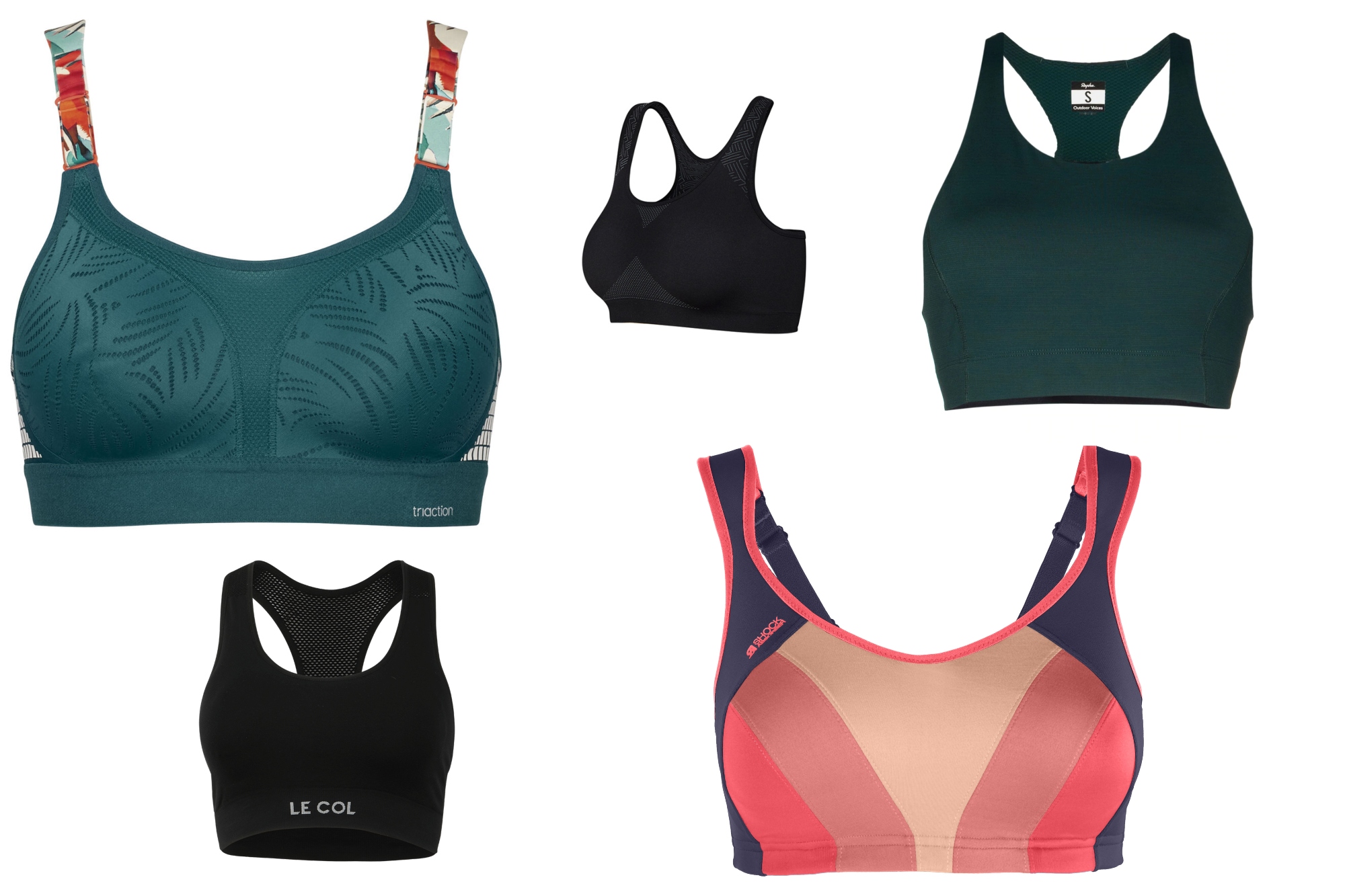

This feature appears in our celebratory women's issue of Cycling Weekly, guest-edited by Elinor Barker and in shops from March 4 - March 10
Finding the best sports bra for cycling is no easy task - sports bras represent a major area of improvement for the current crop of cycling clothing brands. However, we've put a selection through their paces and found some clear winners both in terms of providing support and breathability.
The primary issue in finding a good sports bra for cycling lies with the fact that a piece of clothing that sits against the skin during high-intensity activity needs to be breathable and to wick sweat, whilst supportive or compressive fabric generally needs to be denser.
Female cyclists with less breast tissue to support are likely to choose a light, low support bra which will co-operate with a base layer and jersey combination designed to keep the skin cool and dry. Those requiring more support will either sacrifice this, and spend their rides weaving between potholes to avoid bounce, or endure the cold and sweaty caress of a compressive but damp sports bra acting as a layer between the skin and those high-quality base layers brands spend so much time and energy designing. This is a particularly unwelcome sensation during coffee stop breaks on long winter rides.
The second trade-off is between the comfort afforded by a stretchy construction minus chafing hooks and eyes, vs the ease of removal afforded by a back fastening, which does away with that post-turbo thrashing somewhat reminiscent of a salmon caught in a damp net.
Sports bras for cycling: the options
When working on the study 'How the characteristics of sports bras affect their performance' researchers at Portsmouth University split bras into categories, based on ten characteristics.
The first of these characteristics was 'bra style'. There are three of these:
- Compression
- Encapsulation
- Combination
Most bras created by cycling specific brands fall into the 'compression' category. They are designed to restrict breast movement by flattening the breasts against the chest wall. These often have wide shoulder straps, a larger back panel and are usually taken on/off by pulling over the head. Compression style bras provide the lowest level of support, and it's likely that cycling brands choose them because road riding is relatively low impact and therefore doesn’t require as much support as running or mountain biking. This style of bra is typically the quickest drying, as well.
The encapsulation style has completely separated and defined cups. Some encapsulation sports bras include moulded cups and underwire to separate each breast however with advances in design, separation can also be created without the use of wire.
Finally, there is the combination style, which encapsulates each breast, and then adds a front panel which provides compression. Those who have larger breasts or enjoy off-road riding would likely be better served by an encapsulation or combination style bra as these provide more support.
The researchers also looked at underwire presence, shoulder strap adjustability and configuration, principle fibre content, underband adjustability, cup padding presence, underband closure type, underband closure location and neck drop.
They found that the bras that were most effective at restricting breast bounce had an encapsulation style, padded cups, nylon as the principle fabric, and adjustable underband and high neck drop.
Best sports bra for cycling: combination and encapsulation bras
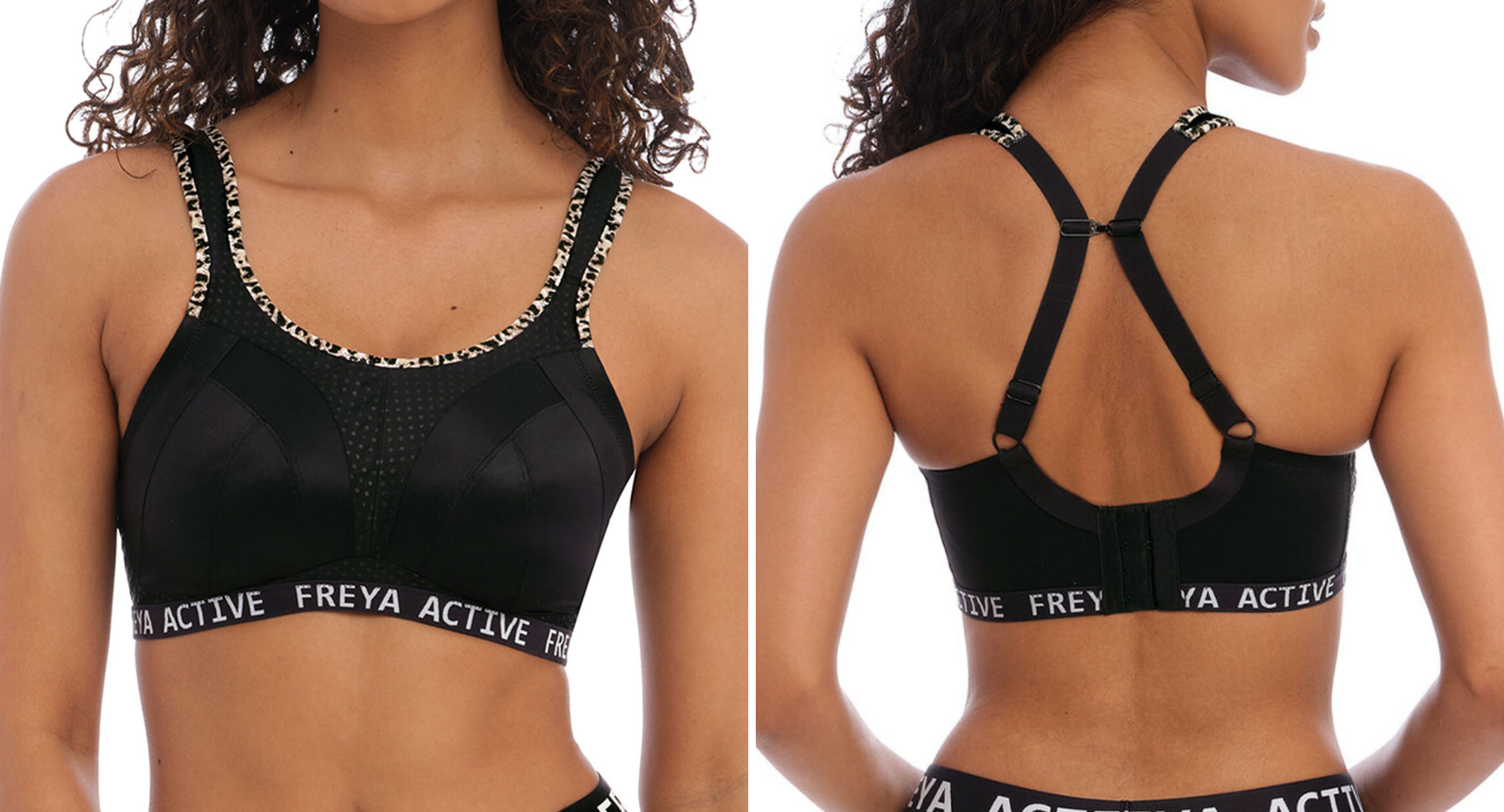
Specifications
Reasons to buy
Reasons to avoid
A 'go to' for our tester, this encapsulation style bra features a lightweight fabric, and dries more quickly when compared with combination models. The straps are wide and soft, and a j-hook allows for extra support for higher impact activities.
The band is wide, and there's a plethora of hook-and-eyes, allowing you to find the right fit, even if that fluctuates.
Freya offers a wide range of sizes, from 28 to 40 in the band and C to J in the cup.
Our tester tried this bra in a 28G, 28GG and 28H, throughout a journey through pregnancy and breastfeeding, with experts at Boobydoo offering expert support with online fittings. The bra performed well, lasting up to a year with good performance, and proving suited to everything from cycling to running and plyometrics, the review concluded "there's everything to love about this option from Freya."
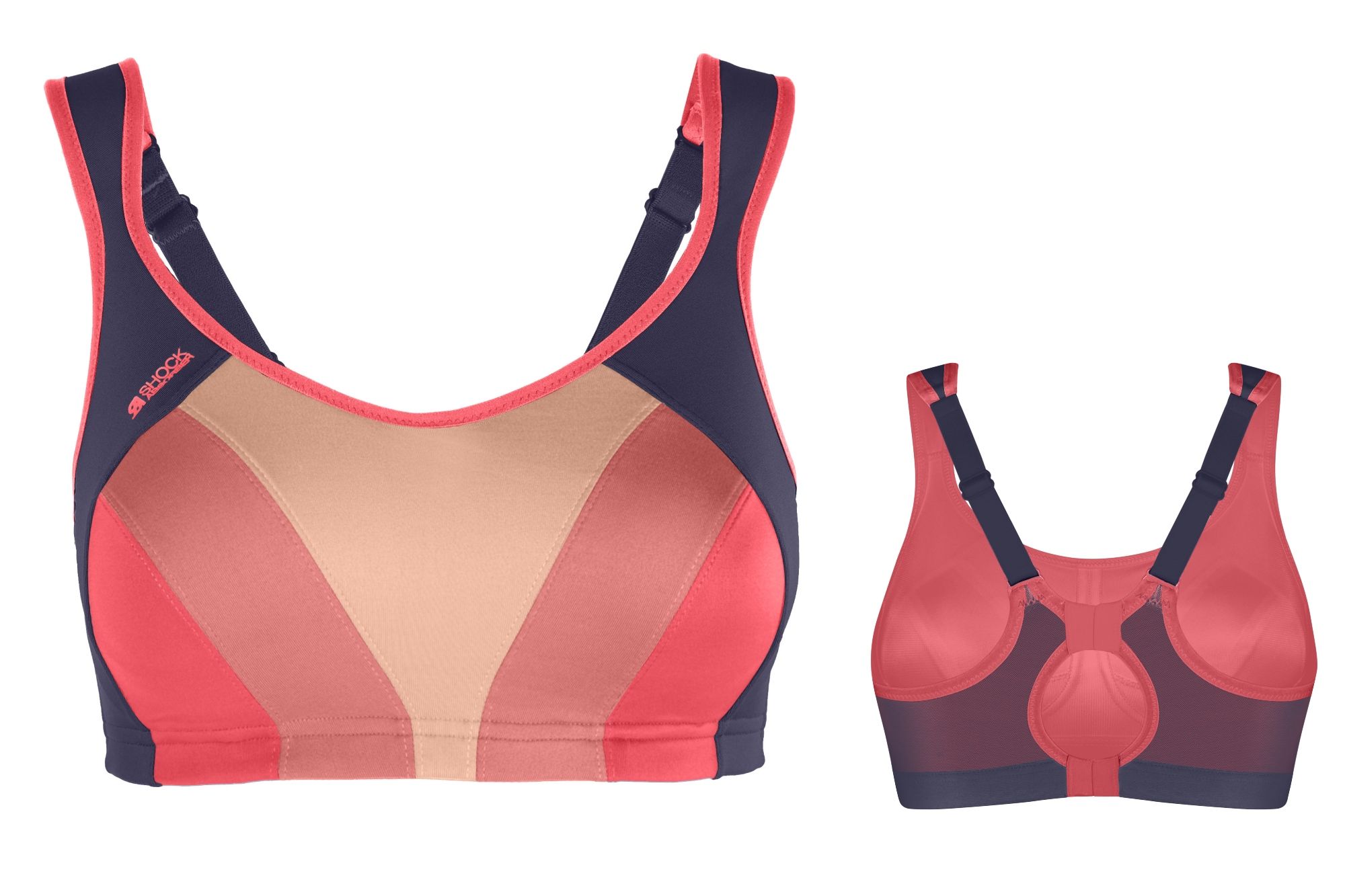
Specifications
Reasons to buy
Reasons to avoid
This is a ‘combination’ bra, meaning it combines compression and encapsulation to offer support. The inner layer uses ‘Simplex’ to encapsulate each breast, and then over the top is a classic crop top style which provides compression. The University of Portsmouth’s test found this style reduced breast bounce by 74.7%.
The Multi Sports bra uses a racer back, with two hook and eye clasps as well as adjustable straps. We’ve had several of these bras in the past, and they have all lasted excellently through many wash cycles, with the hook and eye wires only failing after a good few years use.
The band comes up much tighter than a standard, non-sports bra - it is advised that you go up one band size, but maintain the cup size. Our tester wears a 28E or 30DD (brand dependent) and got on perfectly with the 32DD so this rings true. Being narrow, the band can be felt when breathing hard, but was not restrictive.
The sides are made from a power mesh, to aid quick drying. However, this is ultimately where this bra falls down. The support is excellent but this bra does not dry as quickly as a simpler 'compression' style bra.
That said, of the three combination/encapsulation bras we tried, this was our favourite.
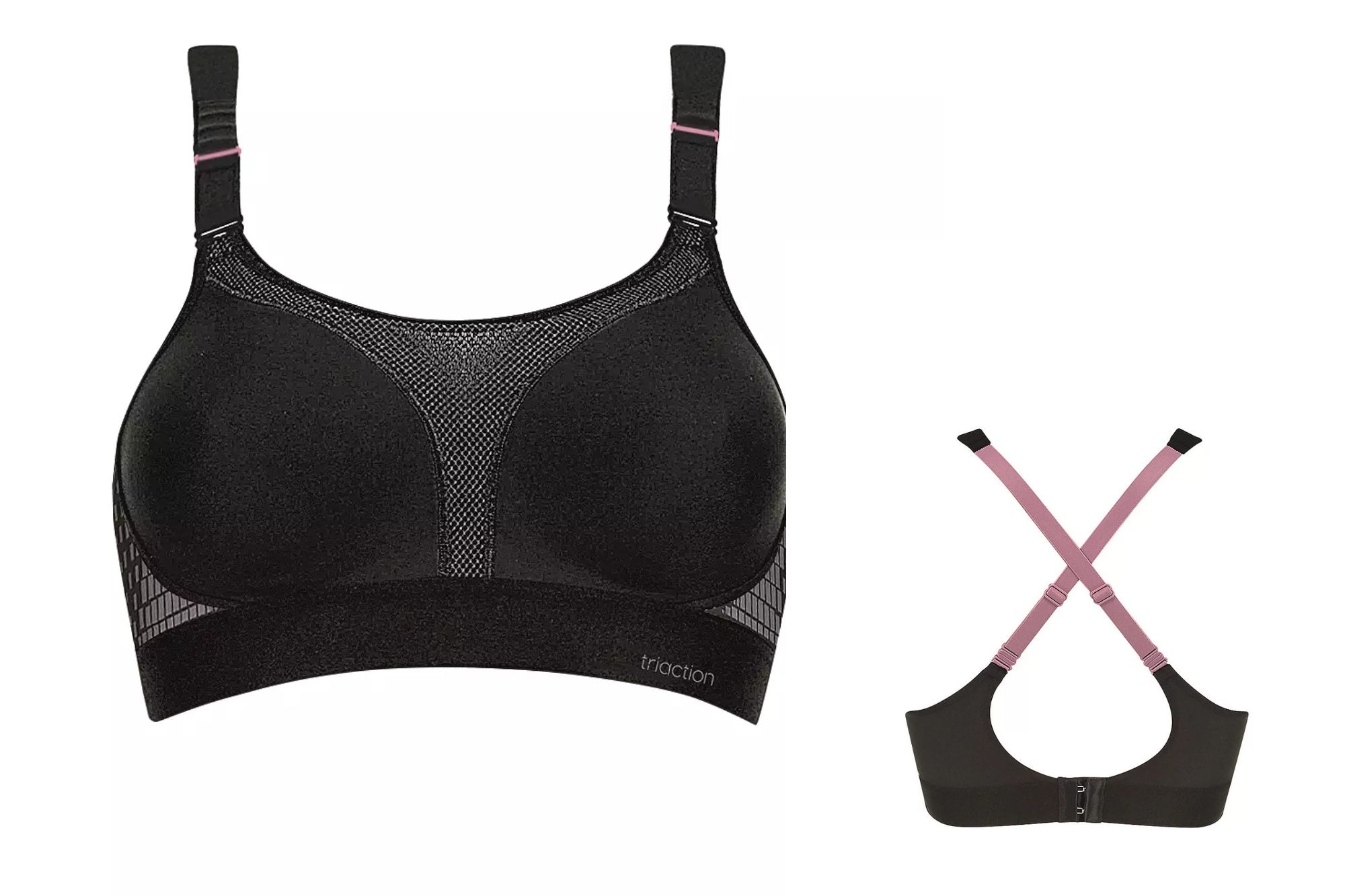
Specifications
Reasons to buy
Reasons to avoid
The Triumph Triaction Extreme Lite provides an excellent combination of great support and quick drying properties.
The bra is a compression and encapsulation combination bra, with non-padded shaped cups that sits closely and supportively around the breasts.
The wide chest band is constructed from elastic with a soft facing on the skin-side. It’s a good blend of just enough stretch to move with you and not feel constrictive while working out, while also providing enough support in conjunction with the rest of the bra design.
The shoulder straps have two points of adjustability, and can also be worn in a crossover style if you prefer a racer-back fit. The top of the straps is wide and constructed from a sturdy but soft fabric with light padding which doesn’t chafe or add pressure, and also doesn’t slip down when exercising.
One of the big selling points of this bra is how well it handles hot conditions. The section of the bra above and between the two cups is constructed from a fine mesh and the fabric to the sides and back is a combination of mesh and lycra which allows sweat to wick away effectively.
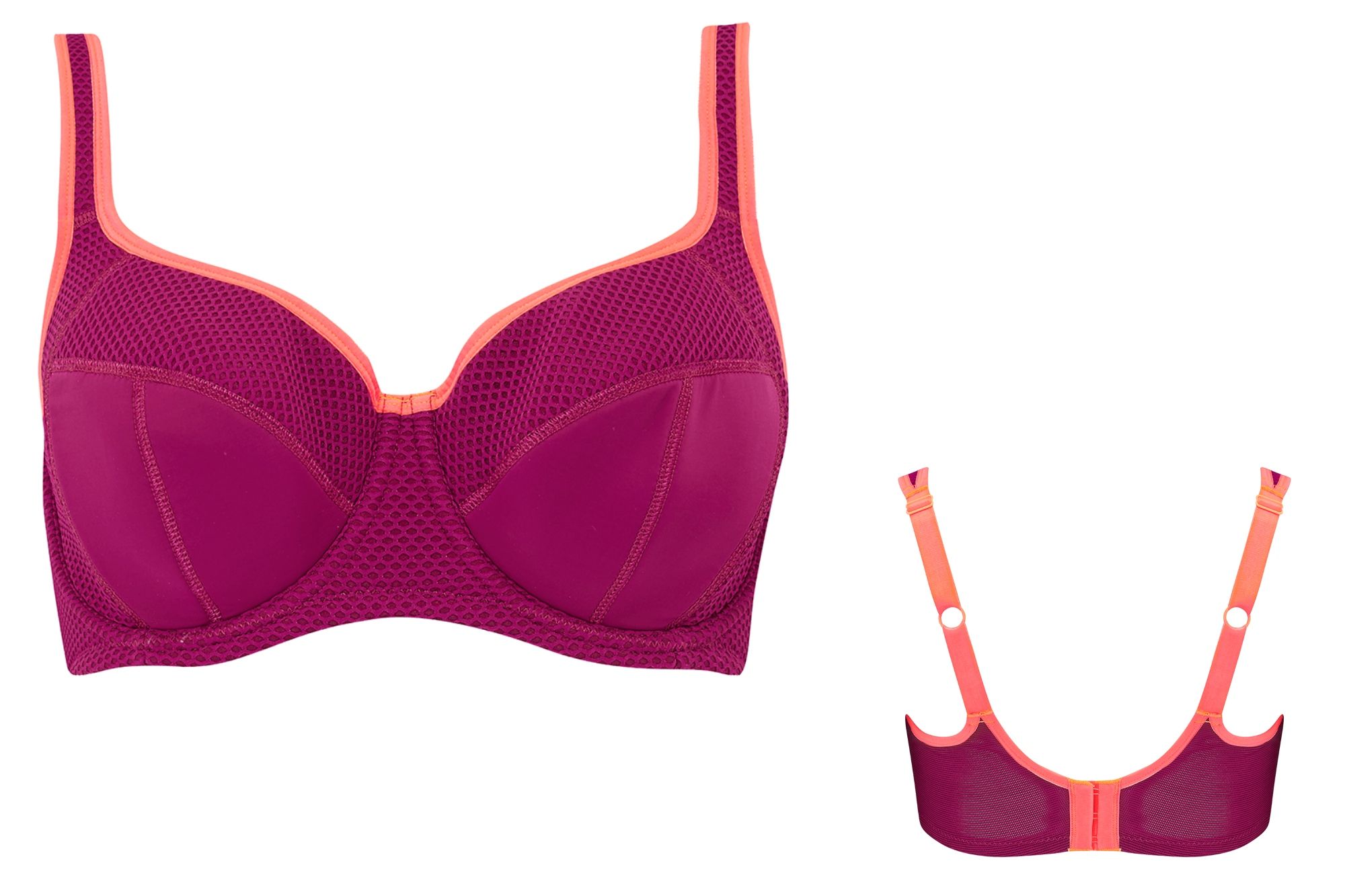
Specifications
Reasons to buy
Reasons to avoid
The Pour Moi Energy Reach is an underwired and lightly padded encapsulation-style sports bra. Each cup has a four-panel construction including side sling which helps support the side of the breast.
The padding is minimal and the internal cups feel soft against the skin, though we found that in hot weather the foam padding soaks up sweat (or rain) like a sponge. It’s therefore not ideal for high intensity rides, very hot or very wet days.
The chest band is stretchier than other sports bras we’ve tested. On the upside, this means it doesn’t feel constrictive but on the downside it doesn’t give as secure a platform for reducing boob bounce. We found it more than up to the task of road, gravel and mountain biking but would look elsewhere for running.
It has a wide chest band with three hook and eye fastening. Added padding at the fastening prevents chafing, and the shoulder straps are also comfortably wide, padded, and have an optional hook fastening so the bra can be worn racer-back style.
While aesthetics never trump comfort and support, we felt this sports bra gave a nice shape, as opposed to squashing our boobs against our upper body like other sports bras do.
Best sports bra for cycling: compression bras
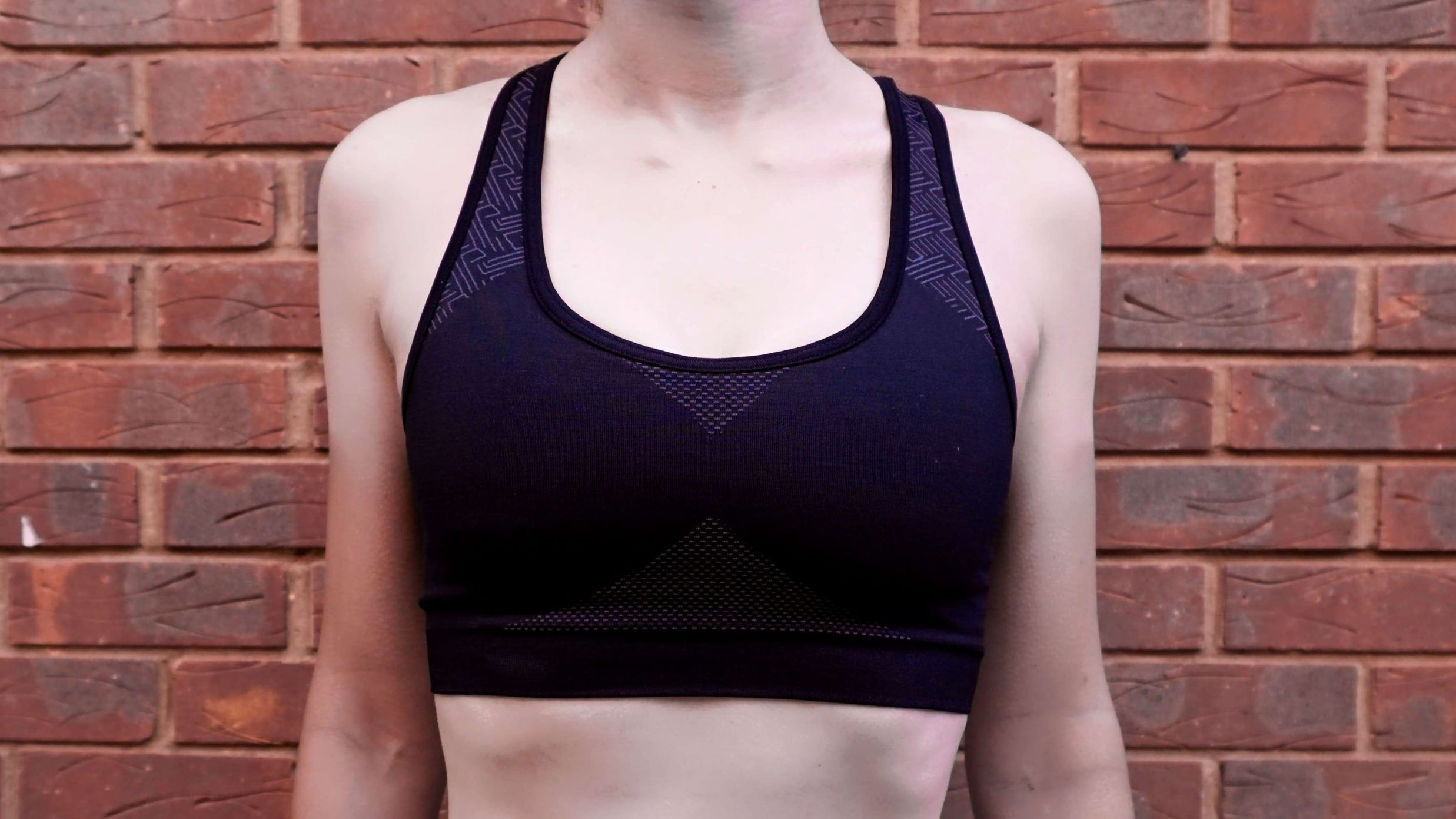
Specifications
Reasons to buy
Reasons to avoid
'The Rosalie sports bra offers broad back and shoulder straps which play well with bib shorts. However, the straps are not adjustable.
The material sits softly against the skin and the bra's largely seamless construction helps with the comfy fit. The lower band is where the Rosalie sports bra excels, it did not cut in uncomfortably, nor feel restrictive.
Our tester wears a 32C in regular bras. Although the support is designed for only low impact activities, it performed reassuringly well when paired with a race fit summer jersey across both shorter and longer intervals on a ride. With a relaxed jersey there was a bit more bounce.
The double layer design still kept our tester sufficiently cool and she had no sensations of unpleasant clamminess. Although a touch damp after riding, the fabric dries incredibly quickly.
After a ride, this bra left faint red marks on the skin around the underarms, and it did feel tight on. This tightness feels reassuring, and certainly is not to the extent that it’s painful, but a tweak in fit could avoid the chafing.
This bra provided the holy trinity of comfort, optimum compression, and effective sweat wicking for our tester - but may not be enough for those with larger chests.
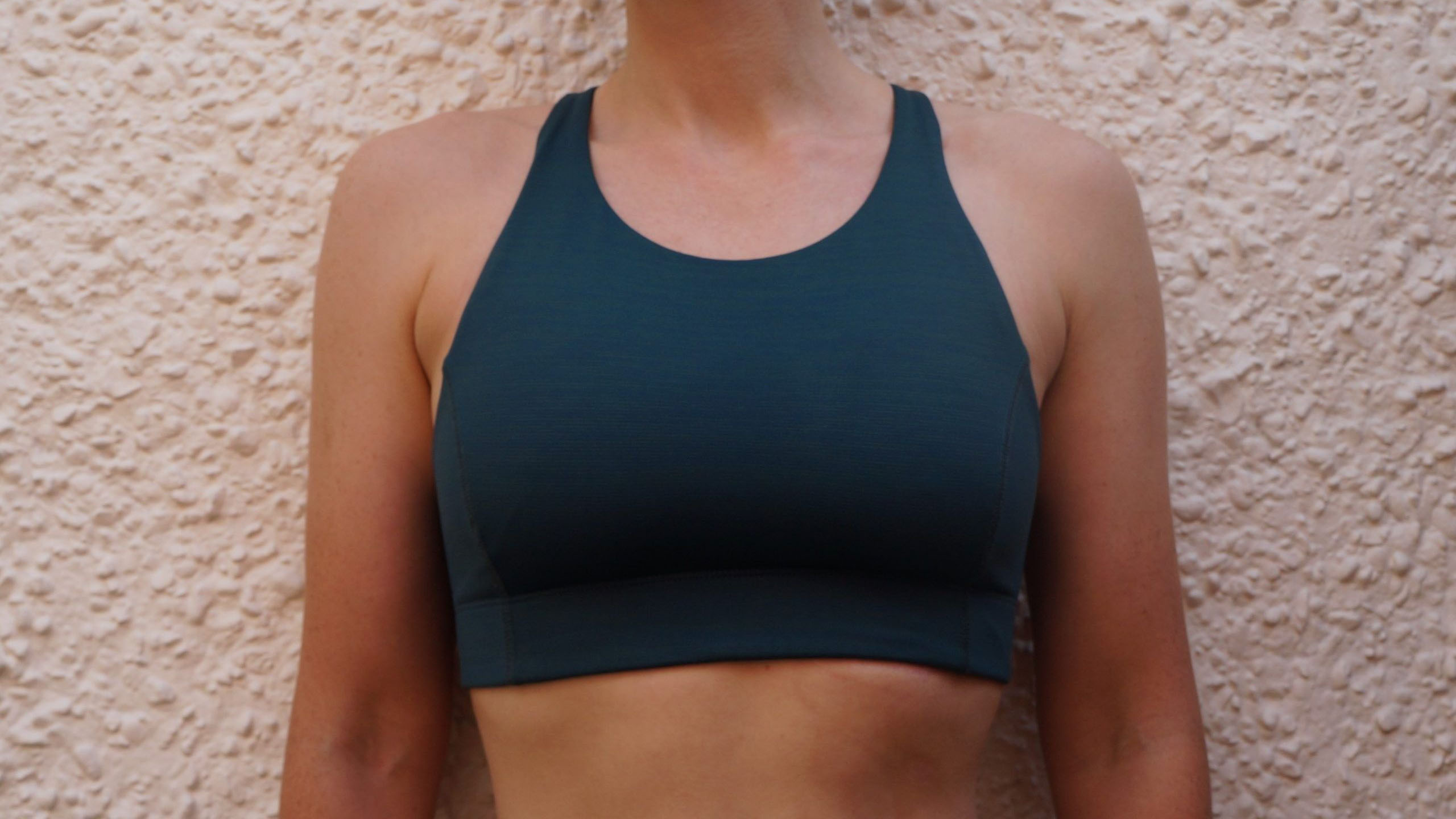
Specifications
Reasons to buy
Reasons to avoid
Rapha's sports bra features a high front, there’s a lot of coverage on offer, meaning our tester could wear it alone without feeling self-conscious over cleavage. The back panel splits into two, creating a nice aesthetic usually only seen in the ‘athleisure’ ranks, whilst a strong elasticated band at the bottom keeps it all in place.
Out on my road bike, our tester was well supported and didn’t have to put up with any bounce. However, this is a light support bra and we wouldn’t choose it for other activities like mountain biking, plyometrics at the gym or running for cross-training over the off season.
Our tester wears a 28E/30DD and the lack of differential between band and cup size was an issue in choosing a size, the X-Small offered a good fit on the band but resulted in overspill either side. The lack of strap adjustability also lets it down, and this became more pronounced over time and washes.
The bra features perforations at the back, and in terms of quick-drying and breathability, the Rapha + Outdoor Voices bra can compete with some of the best. It’s just a shame the trade-off is less support.
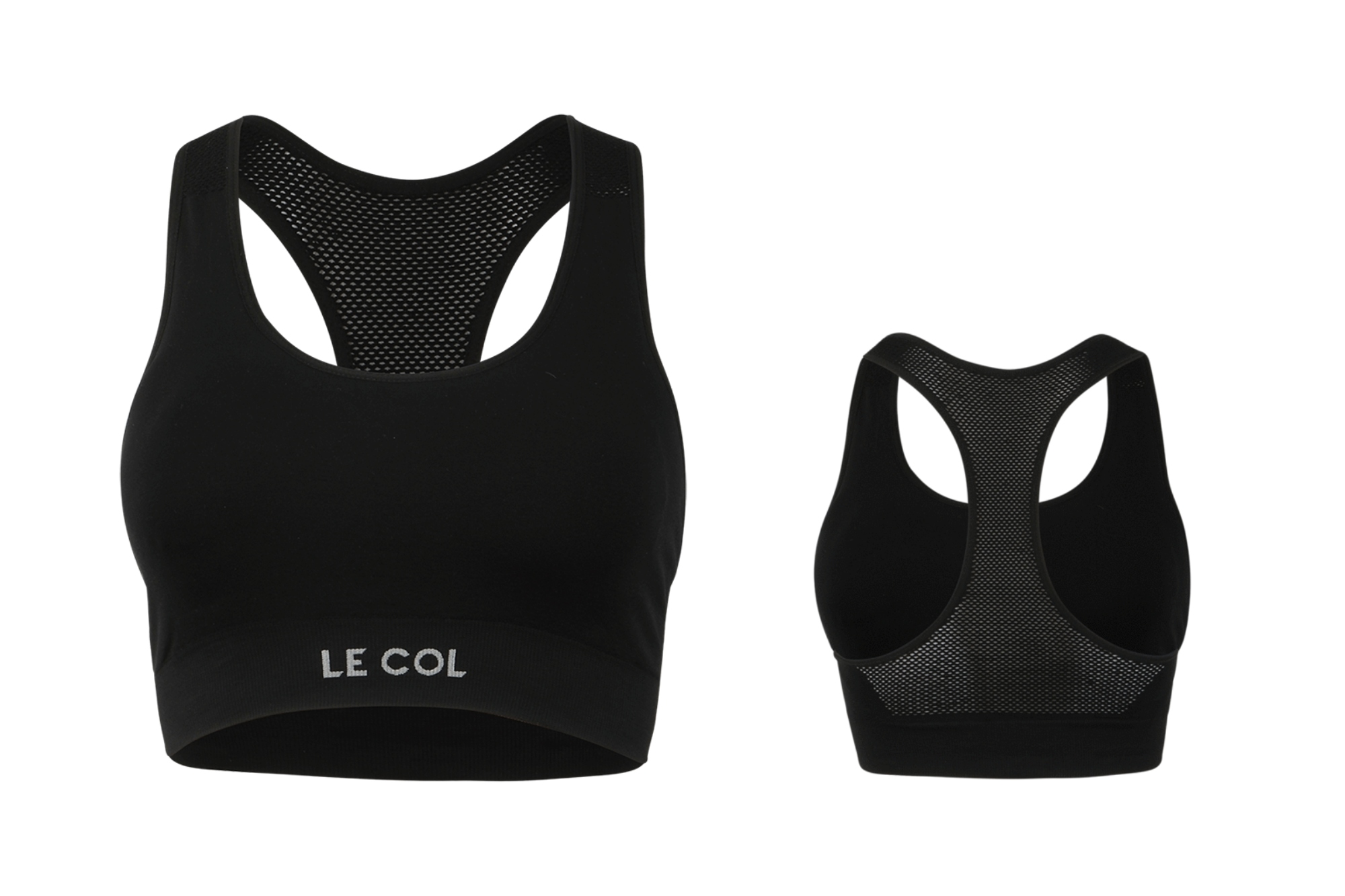
Specifications
Reasons to buy
Reasons to avoid
Le Col’s sports bra is another compression style bra. The seamless construction is made from a single knit, with the fabrics at play being Polyamide (95%) and Elastane (5%). This style aims to remove irritation, and the brand has used a perforated fabric on the back and straps to provide airflow and therefore breathability.
During sweaty turbo sessions, the breathability features were a welcome attribute and our tester reached for this bra repeatedly for high intensity indoor workouts.
Unfortunately, this bra can’t offer the level of support you’d get from an encapsulation or combination bra, we’d leave this one in the draw for anything higher impact such as gravel or mountain biking, and it doesn't pass the 'jump test' so we wouldn't opt to wear it for cross-training such as a run or plyometrics in the gym.
There are no labels, with all information woven in via a white thread. We didn’t experience any chafing or find any red marks left after a ride.
The bra came with removable inserts, which we chose not to use on test but could be a bonus, for example when reaching the top of alpine climbs to discover a sudden change in temperature.
This is also the most expensive on test - coming in at £60, which is hard to justify against the competition.
The verdict
We split our test into two parts: three high support styles, and three compression bras.
Shock Absorber's Multi Sports Support Bra was the winner in the former category, offering next to no bounce, with no rubbing or chafing and quick drying back and side panels, even if the front section did soak up a bit of sweat. Triumph's contribution is best at dealing with sweat, whilst we liked Pour Moi's Energy Reach bra for the flattering shape it created.
Of the compression bras, the best on test was the Café du Cycliste Rosalie sports bra, it offered support and dried well. Rapha's bra carried the cool aesthetic associated with athleisure brands but lacked support, whilst Le Col was perfect for sweaty turbo sessions but had a price tag well in excess of the competition.
Supporting research
Whilst there is no research, to our knowledge, that looks specifically at sports bras for cycling, there is more and more work going into understanding breast movement and breast pain and its role in exercise.
Brogan Horler is aSenior Research Associatefor the Research Group in Breast Health, based at the University of Portsmouth and worked on the 2020 study 'How the characteristics of sports bras affect their performance'. We caught up with her for a quick Q+A.
Why is supporting breast tissue so important?
The problem lies with the breast itself. It does not have any muscle or bone within it and unfortunately has very limited intrinsic support. The only supporting structures it has are the overlying skin and the Coopers ligaments. However, even that is misleading as the Coopers ligaments are not true ligamentous tissue - they do not connect bone to bone and are quite weak. Bras prevent excessive movement which can potentially cause pain and damage to the supporting structures of the breast.
It has been reported that skin has a strain limit of about 60 per cent of its length e.g. if you took a 10cm piece of skin and stretched it to 16cm it would recover. If you stretched it beyond 16cm you may start to cause damage.
For women who experience breast pain, a good sports bra can help to relieve that by holding the breast tissue in place.
What should women look for when buying a sports bra for cycling?
For sports bra shopping in general, we tend to advise women to focus on three key variables:
- Function: is the bra going to be supportive enough for the activity you are doing?
- Comfort: is the bra going to be comfortable enough to wear for the duration of that activity?
- Fit: if the bra doesn't fit properly: this can have a negative effect on the performance of the product?
Research has found that specific sports bra types can benefit women depending on their bra size. A compression sports bra is recommended for smaller breasted women (A-C cup) and an encapsulation style sports bra is recommended for women with larger breasts (D+).
We have recently published a paper on sports bra characteristics and how they affect the performance of a sports bra. We found 5 key features contributed to greater support: an encapsulation style, the use of Nylon as the principle fibre content, padded cups, underband adjustability and a high neckline.
How do we handle the trade-off between sweat-wicking, breathability and support?
There are products on the market that offer high support as well as breathability so hopefully there shouldn't have to be a compromise for cyclists.
However, although wearing a sweaty bra is hugely unpleasant, I would say the importance of reducing breast movement to limit breast damage and breast pain outweighs this. The only caveat would be that you wouldn't want to wear a bra that gets so sweaty it rubs and chaffs the skin causing damage in that way, but bra fit has a part to play in that too.
What to look for in the best sports bra for cycling
Support level
As described above, your options are a compression bra, encapsulation bra, or combination bra.
The compression style provides the least support, but since road cycling is relatively low intensity, many cyclists find this to be sufficient. Those with larger breasts, or who want to eliminate all bounce, would be better served by an encapsulation or combination bra.
Quick-drying and breathability
It's likely you're going to get sweaty whilst riding your bike, so you want your bra to be quick drying. Look for a fabric with wicking and drying properties, and mesh inserts or perforations at the back and sides.
Fastenings and strap style
This one will come down to personal preference. Bras with a rear fastening - such as a hook and eye - are easier to get off, especially when damp and sweaty after a hard effort. Pulling a wet, compressive garment off having hit a new max heart rate is no one's idea of fun. However, these features can chafe or rub which is why some women prefer to avoid them.
In terms of straps, adjustability introduces an extra opportunity for rubbing too - but can prolong the life of a bra as the straps can be adjusted as washing takes its toll on the fabric. This also allows for a better fit, and for those seeking more support we would recommend adjustable straps.
Wide straps distribute pressure, reducing the chance of red marks at the end of a ride - and a wide underband also tends to serve the same purpose so is also a feature we'd suggest looking out for.
Cycling-specific brands will design their bras to sit well with bib straps on cycling shorts. However, in our experience, cycling short bib strap styles vary dramatically and we've seen no major benefit from matching them up.
Padding
Researchers at the University of Portsmouth found that sports bras with padding provided more support - something to bear in mind if you're seeking a greater level of bounce control.
Additionally, padding can help to provide extra coverage in the event that changes in temperature create that 'smuggling peanuts' look, this is particularly common at the top of long climbs.
Fit
Most importantly, the bra needs to fit.
The underband should always be level at the front and back (this applies to all bras, not just sports bras), with enough room to take a deep breath without any discomfort.
Your breasts should sit comfortably in the cups, without gaping or overspill, and it's best to buy a bra that fits well with any fastenings on the loosest hook so that you have space to adjust it as time takes its toll on the fabric.

Thank you for reading 20 articles this month* Join now for unlimited access
Enjoy your first month for just £1 / $1 / €1
*Read 5 free articles per month without a subscription

Join now for unlimited access
Try first month for just £1 / $1 / €1
Get The Leadout Newsletter
The latest race content, interviews, features, reviews and expert buying guides, direct to your inbox!
Michelle Arthurs-Brennan the Editor of Cycling Weekly website. An NCTJ qualified traditional journalist by trade, Michelle began her career working for local newspapers. She's worked within the cycling industry since 2012, and joined the Cycling Weekly team in 2017, having previously been Editor at Total Women's Cycling. Prior to welcoming her first daughter in 2022, Michelle raced on the road, track, and in time trials, and still rides as much as she can - albeit a fair proportion indoors, for now.
Michelle is on maternity leave from April 2025 until spring 2026.
-
 'I'll take a top 10, that's alright in the end' - Fred Wright finishes best of British at Paris-Roubaix
'I'll take a top 10, that's alright in the end' - Fred Wright finishes best of British at Paris-RoubaixBahrain-Victorious rider came back from a mechanical on the Arenberg to place ninth
By Adam Becket Published
-
 'This is the furthest ride I've actually ever done' - Matthew Brennan lights up Paris-Roubaix at 19 years old
'This is the furthest ride I've actually ever done' - Matthew Brennan lights up Paris-Roubaix at 19 years oldThe day's youngest rider reflects on 'killer' Monument debut
By Tom Davidson Published